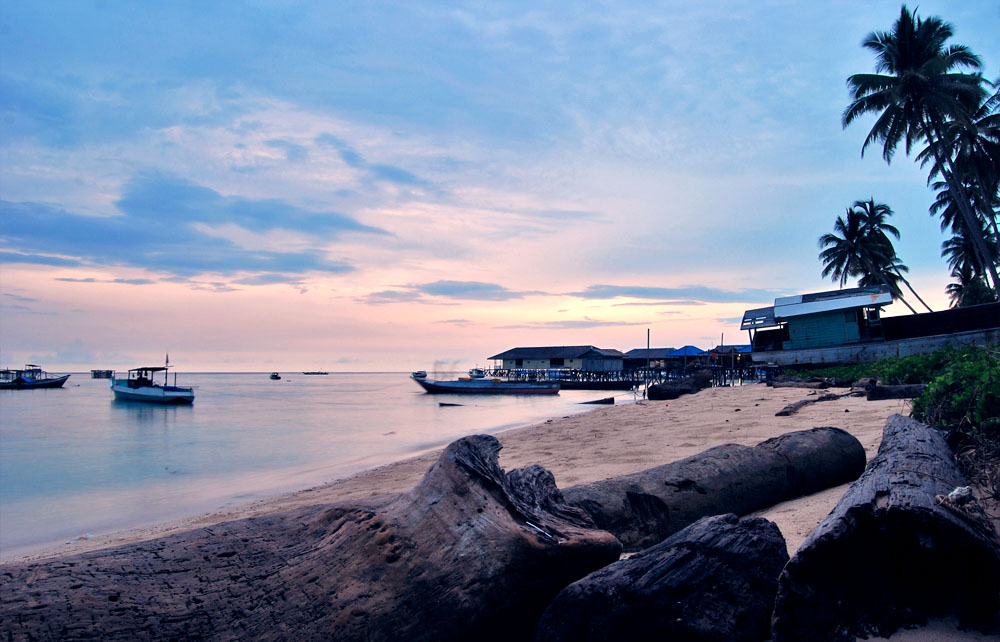Located in the Sulawesi Sea on the coastal shelf of East Kalimantan, these islands have powder-fine beaches, lush interiors and mysterious lagoons with stingless jellyfish. Explore this hidden paradise before the inevitable rush of tourists.
Derawan Island
Derawan is a fishing island about three hours by speedboat from Berau that has developed as a dive resort. Stilted guesthouses suspended over turquoise water, manta rays with seven-metre wingspans and friendly locals are all part of its charm: this is an island that time forgot.
The pace of life here is bucolic and unhurried, and four days can easily turn into a week. Wander the tear-shaped island’s sandy streets and mix with the genuinely welcoming and curious locals over some ikan bakar (grilled fish), before stepping over a six-foot monitor lizard to watch the sky ignite with a spectacular sunset.
Take a room at any of the basic, wooden guesthouses, and head straight to the sea. The reef has been decimated in parts by dynamite fishing, but you will still find a huge amount of underwater life, with a smorgasbord of cuttlefish, octopus, pygmy seahorse, scorpion fish, clownfish and giant green turtles.
Savvy divers head here from all corners of the world, lured by the extraordinarily rich marine life. Derawan Dive School offers diving around the island, as well as diving and snorkelling forays to the nearby islands of Maratua, Sangalaki and Kakaban. The budget traveller should try guesthouse and dive outfit Losmen Danakan (west coast of Derawan Island; 086-8121-6143) who run cheaper, local dives. Not to worry if you are not diving with a tank; free diving down a reef wall beside giant green turtles and manta rays is just as much fun.
Multi-coloured Pelangi Guesthouse (west coast Derawan Island; 081-347-807-078) has basic rooms with balconies jutting out into the Sulawesi Sea for around 183,000 rupiah a night, and can organize diving boats or lend you snorkels and fins. If you are looking for something more upmarket, Derawan Dive School has several high luxe cabanas with polished wood floors and air conditioning for around 300,000 rupiah.
Conservation programs
Up until 2002, the vast majority of turtle eggs laid on the island were collected by locals to sell, representing a major source of income outside of fishing. But thanks to the World Wildlife Federation partnering with the islanders, the beaches where hawksbill and green turtles lay their eggs are now fully protected.
Over the last 10 years, turtles have been tagged, and the volume of eggs they lay has been carefully monitored. If you want to get involved during your stay, head to Losmen Danakan, where the Turtle Conservation Group is based.
You will be able to accompany the wardens and other volunteers on their evening vigil for poachers – and if it is full moon, you will be able to watch mother turtles lumbering from the shallows and up the beach. This new eco initiative is already paying dividends, with turtle populations stabilizing and providing a steady income for islanders through low-impact tourism.
The Sangalaki Archipealgo
Fifty minutes away by boat is the uninhabited and stunningly beautiful Sangalaki Island, where manta rays flock in numbers for the plankton-rich waters. As they flap and soar through the sea, these giants of the deep are as mysterious as they are alien, often staying for a week before vanishing. Alleged cyanide fishing has depleted their numbers, but reports of seeing them are regular.
If manta rays do not pique your interest, a 10-minute boat ride away from Sangalaki Island is Kakaban Island, where a brief walk from the jetty to its interior brings you out by a lagoon where you can swim with non-poisonous jellyfish. With no direct predators, over thousands of years these creatures have lost their sting.
Maratua, another island in the Sangalaki Archipelago, has even greater numbers of non-poisonous jellyfish in its lagoon, as well as a very strange coral reef. Spectral fluorescent spires and swaying technicolour starfish loom out at you as thousands of jellyfish brush up against you in the chalk-green waters. Maratua and Derawan are the only habited islands in the archipelago, and an airport is planned on Maratua for 2013. This would make access even easier, although it is being contested by environmentalists looking to protect the resident hawksbill turtles. There is no direct international flight to Derawan. The only one international airport in East Kalimantan is Sepinggan at Balikpapan. From Balikpapan we could choose to go to Tarakan or Berau with smaller plane. But there is no flight to Derawan. So if you choose to go to Tarakan, you must continue the journey with 3 - 4 hours across the sea by speed boat. If you choose to go to Berau, you must go to Tanjung Batu first by land transportation (it's about 2.5 hours long from Berau) and then take 30-45 minutes journey by speed boat to Derawan.
If you want to go by land transport from Balikpapan, you will take about 750 km to reach Tanjung Batu and then take 30 minutes journey by speed boat to Derawan. It is a long and hard way. It could take 16 - 24 hours long because of the condition of the road. The path is Balikpapan - Samarinda - Bontang - Sangatta - Muara Wahau - Berau - Tanjung Batu. Note there is no ATM on the island and changing money is not guaranteed. You need to bring all your cash with you. There are ATM s in Berau. Derawan in itself is not in itself the perfect diving spot, but it’s a great hub to discover the other islands. You can stay in Maratua or Sangalaki resorts, but prices are much more expensive than in Derawan. Derawan has a lot of local restaurants, homestays, and hotels (cottages), build above the sea. From the cottages, you can spot the giant turtles every day. But they don’t lay many eggs on the shores here. To see this (every night) you have to be in Sangilaki.






